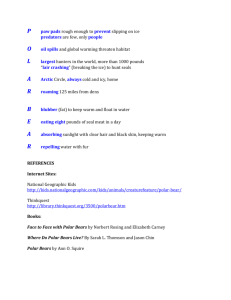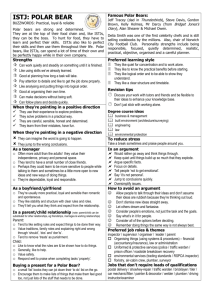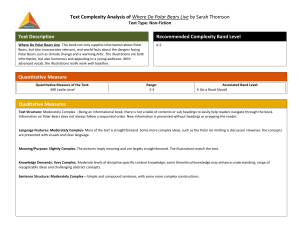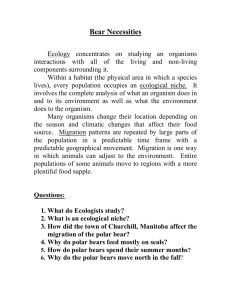The Importance of Marine Wildlife and the Human Impact - tfss-g4p
advertisement
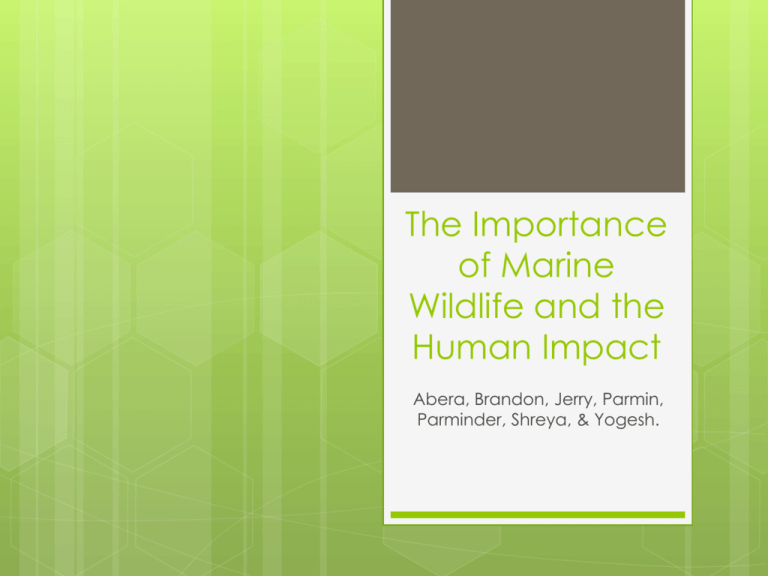
The Importance of Marine Wildlife and the Human Impact Abera, Brandon, Jerry, Parmin, Parminder, Shreya, & Yogesh. Affect of human actions on marine ecosystem Indian Point Work in Progress Difference in vegetation at different elevations Seaweed Rocks and pebbles Seaweed at low tide Animals, seaweed and substrate amount and type at different quadrates Area of a quadrate = Length of transect x Width of transect 34cm 34cm 1156cm 2 1 .2 m 2 Change in Elevation Density of species at different distances Density of Animals = Number of Species Area of quadrate Barnacles Figure 1: Distribution of Barnacles at different transects Number of Barnacles (+/-1) 25 20 15 Barnacles 10 5 0 1 3 5 7 9 11 13 15 17 Transect Number 19 21 23 25 Common Periwinkle Figure 2: Distribution of Common Periwinkle at different transects Number of common Periwinkle (+/-1) 30 25 20 15 Common Periwinkle 10 5 0 1 3 5 7 9 11 13 15 17 Transect Number 19 21 23 25 Smooth Periwinkle Figure 3: Distribution of Smooth Periwinkle at different transects Number of Smooth Periwinkle (+/-1) 3.5 3 2.5 2 Smooth Periwinkle 1.5 1 0.5 0 1 3 5 7 9 11 13 15 17 Transect Number 19 21 23 25 Dog Periwinkle Figure 4: Distribution of Dog Periwinkle at different transects Number of Dog Periwinkle (+/-1) 3.5 3 2.5 2 1.5 Dog Periwinkle 1 0.5 0 1 3 5 7 9 11 13 15 17 Transect Number 19 21 23 25 Scuds (Freshwater Shrimp) Figure 5: Distribution of Scuds at different transects 7 Number of Scuds (+/-1) 6 5 4 Scuds 3 2 1 0 1 3 5 7 9 11 13 15 Transect Number 17 19 21 23 25 Figure 6: Elevation at different transects 110 Overall Elevation (cm) 60 10 1 3 5 7 9 11 13 15 17 19 21 23 25 -40 Elevation (cm) -90 -140 Transect Number Different types of seaweed Rockweed [fucus] Sea Lettuce Why are certain species abundant in one region and not other? Ecological Niche The habitat of an organism and its function in an ecosystem Describes how an organism adapts to its environment when there is an abundance or shortage of resources and competitors Determines the presence or absence of species under different circumstances Scuds are freshwater shrimp (Amphipod) Hide among the weeds and under rocks or debris Live mostly in areas where there is concentrated aquatic vegetation The highest amount of scuds found in a quadrate is in number 17 It consists of 100% knotted rag and 90% mud Other factors affecting presence of species in an area Salinity Proximity to water Sunlight intensity Elevation Correlation between elevation and presence of common periwinkles common periwinkle is densely located in areas with low elevation and as the elevation increases, the density of common periwinkles decreases Limiting Factor a condition that affects the population of a certain organism, if it is absent or insufficient in a habitat i.e. the change in elevation was the limiting factor for the transect lab The change in elevation in turn determines: the vegetation growth (e.g. seaweed) of that location the amount of water present at the location [high/low tide] Elevation changeVegetation growth Depending on the type of seaweed present in the location, different species are found the type and amount of seaweed determines the amount of food source available for the bigger species which determines the amount of species present in the region Elevation changeHigh/Low tides the elevation affects the amount of waves that reach the location determines whether intertidal or subtidal organisms will be present in these locations. Elevation changeHigh/Low tides The organisms present in these regions will be determined according to their body structure, whether they are able to handle high tides or only low tides. Some organisms prefer lower elevations since they can easily be spotted by their predators at high elevations. Natural Selection of Species certain species are more adaptable to different habitats, have a higher chance of surviving than the species that can not adapt to different conditions e.g. the common periwinkle has a higher chance of natural selection than the dog periwinkle and the smooth periwinkle Natural Selection the common periwinkles are found throughout the whole transect in different substrates including gravel, rock and mud the dog periwinkle is only found in two muddy quadrates and in very small numbers, due to its low ability to adapt to different habitats. Natural Selection the smooth periwinkle, Littorina obtusata, is able to survive some extreme exposure and temperature; however it is not as well adapted to being out of the water as the rough and common periwinkles The smooth periwinkle’s ecological niche is the lowest reaches of the lower intertidal region. Effects of rising temperatures on ocean animals We think of animals such as: Polar Bears Sea Turtles Right Whales Polar Bears Frozen Iceland will turn into open water causing the bears to swim for longer distances between areas of stable ice. That will mean there is less time and energy for reproduction. Polar bear population will go down Polar Bears Cont. With rising temperatures, these sea ice is decreasing in numbers, effectively making the polar bears travel farther distances between safe resting places. Since they use it for hunting, less sea ice means more competition for ice platforms, which means more polar bears go hungry which means that they acquire diseases and die quicker. A 2007 report from US geological services predict that if there is a decline in sea ice, what is now a 22,000 strong polar bear population would decrease by two thirds to just over 14600 by 2050 Polar Bears Cont. Reduced stock of its primary food... The Ringed Seal Delicious Polar Bears Cont. Polar bears use ice as a platform for hunting, preying and nesting. Also, rise in temperatures means less seals are alive. Thus, the food is also being diminished. Less food, less ice, same number of polar bears will lead to more competition, causing many bears to die off. Polar Bears Cont. A 2005 report says if there is a complete loss of summer sea ice cover, the polar bears are highly unlikely to survive Polar Bears Cont. Polar bears are listed under “threatened species”. A threatened species is primarily defined as “highly likely” to be endangered in the future Sea Turtles Are on the list for endangered species. Females lay eggs in the sand at beaches. Sea turtle gender is largely based on the temperature during incubation This means that if the temperature is high, the sex ratio will be biased toward females. Sea Turtles Cont. Low level beaches like in the Maldives and the great barrier reefs will be covered with water if the ice caps melt due to high temperature. This will mean less places to lay eggs on. Feeding patterns of the turtles will be altered since the sea grass beds would be in decline due to higher water temperatures Right Whales Endangered and protected since the mid 1930s (300 – 400 individuals left in the world) Human activities such as whaling and commercial fishing is to be blamed. Right Whales Cont. High temperature means less food for the zoo plankton. Female whales can't prepare for calving without high amounts of zoo plankton. Changes of sea water temperature, wind and water currents can affect the patch formation of zoo plankton. Right Whales Cont. Scientists allege that increase climate variability or prolonged period of negative NAO index (causing decline of zooplankton) will inhibit the already tenuous recovery of the right whale. Lobsters Cold blooded, and if temperature rises, it causes cold blooded animals to use more energy for respiration, leaving less energy for growth, feeding, energy storage, immune response and reproduction. Temperature of the ocean floor immediately dictates success of breeding and migrating patterns. Lobsters Cont. Research found that when water temperature rises above 20.6 C, the respiration rate increases to a point where their demand for oxygen exceeds the supply that is dissolved in the water causing physiological damage Studies have shown rising seawater temperatures cause/ helps spread lobster shell disease. Lobsters Cont. One SURPRISING observation is that there has been an increase in numbers of lobsters in the gulf of Maine. scientist speculate that it may be due to that with warmer waters, a longer growing season is spurred, encouraging more rapid growth, causing lobsters to hatch earlier and provide better conditions for larval lobsters. Soil Fertility and More The mudflats surrounding the Bay of Fundy were formed when continental plates parted millions of years ago. The mud flats, however, were created as the surrounding cliffs of soft siltstone and shale were eroded by strong tidal currents in the bay. The tides can also be contributed to the structure of the mud flats. Large quantities of minute sediments flood the coastal area during each tide cycle in sheltered areas along the coast most of the sediment remains, creating the mudflats. When the tide recedes, in the exposed mud surface, lays millions of small Crustaceans or their pinhole burrows. Shorebirds feed on the exposed creatures. Phytoplankton The water is very cloudy due to the churning of the water caused by the tides. Thus, sunlight cannot reach deep underwater, preventing the phytoplankton from photosynthesizing. When the tide recedes, large deposits of nutrients are left behind, fully exposed to the sun. Thus, this results in low productions of phytoplankton production in the water but extremely high quantities on the mudflats. Phytoplankton Migratory Birds At Johnson's Mills at the Bay of Fundy shorebirds land to feed on the mudflats. The birds feed on tiny marine creatures in the nutrient rich mudflats before continuing their migration to the Canadian artic to South America. Each bird will eat at least 10-20,000 mud shrimp every low tide. Significance of Mud shrimp to the structure of the Mudflats Positive: They build u-shaped burrows which compact the surrounding sediment. These tunnels also stick together resulting in a large network of tiny erosion resistant tunnels. This creates a strong structure within the mud to protect it from being washed away by tides. Significance of Mud shrimp to the structure of the Mudflats Negative: They eat Diatoms, bacteria and many microorganisms that secrete sticky organic glue-like organisms which hold the mud together. The secretions protect the mud from being easily swept away by tides. Types of Soil The mudflats were developed form the materials deposited by glacial ice in the form of boulder till, sands, gravels and fine-textured sediments that settled out in glacial lakes. They hold mineral content. The soils closer to the coast consist of more stone and therefore are more leached and supplied with less nutrients in comparison to the upland soils. Types of Soil Cont. Most soils are acidic. They are acidic due to the type of material from which the soils were formed and the very high precipitation in the region.1000mm of precipitation in the region results in severe leaching of certain elements including calcium, magnesium and potassium from the surface. This makes it strongly acid and relatively infertile. Sediment Sediments are the basis of the mudflat. Erosion of shorelines (often sedimentary cliffs) produces the sediments that are transported to the mudflats. Factors that make sediments of mudflats stick together include the presence of diatoms (singlecelled plants), moisture content and particle size. Sediment Cont. In the presence of water, smaller particles have an attractive force between them, keeping the water molecules locked between the particles. This keeps the mudflats moist and prevents the water from draining out. This affects the amount of oxygen and relative compounds within the mudflats; determining the abundance of species that can live within it. Salt In the summer, as heat increases evaporation, the salt content in the mudflats. This causes stress within the organisms living in the habitat. Likewise, if there is increased freshwater in the system, then reduced salinity will also bring upon stress to the organisms. Temperature Temperature can affect the structure of the mudflats. High temperatures will leave the mudflats to dry out. Strong winds may lead to erosion of the mudflats in such conditions. In colder climates, where the temperature is below zero, the surface can freeze. This can have a negative impact on the organisms whom live in the habitat. Movement, deficiency of prey populations, etc. can lead to the decline of the populations of many species. The rising and falling of tides, alters the shape of the mudflats. It may cause erosion, leeching, etc. Who lives where? Dichotomous Key Figuring out a species or genus of an animal from thousands can be confusing, even with a description. A dichotomous key is the simplest and most efficient way to differ between any kingdom, phylum, family, genus, and species. A dichotomous key has both advantages and disadvantages to it's use, especially when it comes to individual variation. How It Works A dichotomous key is a simple tool which classifies objects through its natural descriptions, i.e. smell, colour, texture, shape, etc. It starts off with two simple options that define the object, and then narrows it down while eliminating all other possible objects. A series of double statements follow, eliminating further possibilities and allowing one to reach a conclusion. Pros Very effective and efficient Easy to use Universal Cons Incorrect information or descriptions can lead to incorrect conclusions Genetic disorders can cause fluctuations in the specifics vs. the general description of the organism. Dichotomous Key Interactive Video: http://www.youtube.com/watch?v=nb4zj 967qHs Please visit. Created by Yogesh Gupta. Sea Stars Sea Star Adhesion • How well can sea star (Asteroidea) adhere to a surface (tube feet strength)? Sea Star Reactions • Sea Star reacts defensively to stress • Positions itself where it can hold on • Widens arms and spreads out Tube Feet Movement Use water vascular system Changes in water pressure within the channels of the echinoderms Suctions cups on the oral side to extend and contrasts arms for movement Move very slowly, most of adult life spend stationary Tube Feet Feeding and Respiration Use tube feet to move food towards the mouth of the echinoderm Get oxygen from water sucked in through tube feet Tube feet sensitive, used to identify and find food What we learned Echinoderm are very intelligent and have developed techniques special to them (flipping themselves) Star fish have the ability to regenerate broken limbs Studying how they do so aids in regenerative medicine How we differ from other life, and what can we learn from other life (tissue repair) Sea Stars: One World Tube Feet: Uses Locomotion Passing food to mouth Surface adhesion Tube Feet: Importance Allow sea stars to act as keystone predators Keystone predator: organism that plays significant role in maintaining structure and balance in ecological community by preying on other organisms How are Sea Stars Keystone Predators? Sea stars prey on species that do not have any other major predators in community (ex. oysters, clams, mussels) By preying on these species, sea stars keep them from overpopulating Consequences of Overpopulation Overpopulation of species such as clams, mussels and oysters can cause their prey to become endangered Overpopulation would also lead to a lack of biodiversity Ecosystem would not be able to function properly Sea Urchins Phylum Echinodermata (“Spiny Skin”) Echinoderm is the common name for approximately 6000 living species. The Echinoderm Phylum consists of marine animals such as Starfish, brittle stars, sand dollars, sea cucumbers, and sea urchins. Echinoderms usually have radial symmetry in their structure. As well as being equipped with tube feet. Echinoderms – Sea Urchins They are found commonly at the bottom of the ocean. In this case Sea Urchins are grazers at the bottom of the ocean. These grazers are feeders of small particles at the bottom of the ocean. Thus, they are found in the deep sea. Sea Urchin- Scientific Classification The name sea urchin is a general name used for around 700 species of echinoderms that have the same appearance and structure. Sea urchins belong to the class Echinoidea. Sea urchins with gills belong to the order Centrechinoida, and those without gills belong to Cidaroida. Reproduction In the sea, the male sea urchin will release his sperm into the sea while the female urchin releases her eggs. When and if the eggs and sperm touch a new baby urchin will form. Growth Once the gametes become fertilized, a larva is formed. For Sea urchins, this larva is known as a pluteus. It is nearly impossible for one to determine the sex (visually) of the urchin until it becomes an adult and releases either a sperm or an egg. Experiment with Tube Feet An experiment at the trip was attempted to test the adhesion of the sea urchin to a surface. The purpose of this was to see how the tube feet are used and how it can come in handy for the echinoderms in the sea. Materials Multiple Sea Urchins (Depending on the number of trials desired) Fishing Line Plastic Bag Rocks (gravel) – substitution for lead weights Upside Down Stool Large Bowls Salt Water Centigram Balance (1 decimal place) Paper Towels Procedure Before we proceed with the experiment, gather all the required materials and create a controlled a clean space in order to erect the apparatus. To test the sea urchin’s adhesion force limit, we will create a pulley system where the load will be attached to the sea urchin after it adheres to the bowl when submerged in salt water. The following diagram will give a visual representation of how the apparatus will look after created. Based on this apparatus and specified materials, the following data was produced (under specific and special circumstances). Sea Urchin # (picked randomly*) Mass of Sea Urchin (g) ±0.01g Adhesion Force Limit (g) ±β 1 37.8 313.9 2 14.8 295.5 3 3.2 27.1 4 15.2 45.1 5 35.8 96.4 6 54.7 553.5 7 45.8 456.2 8 3.8 72.0 9 24.7 30.6 10 55.1 176.2 *Note: Various urchins were used; a different urchin was selected every time to generate different results and to create a broader scope in order to make a general consensus. β – Due to the fact that rocks were used as weights, the actual adhesion force limit is not very precise. Rocks have various weights and sizes and thus we create variability in the data. Thus, this is a close estimate rather than actual statistics. Analysis If we take a look at the data we can see a trend: As the mass of the sea urchin increases, statistically speaking, it will be able to produce a larger adhesion force limit rather to that of a smaller mass. This is a result of a larger sea urchin (the one with the more mass) would have more tube feet genetically and a greater surface area to disperse the adhesion. With more tube feet along a surface the sum of the individual adhesions culminate into a larger and greater adhesion force limit. Structure Sea Urchins: One World Tube Feet: Uses Locomotion Passing food to mouth Surface adhesion Prevent larvae of other organisms from settling on their surface Tube Feet: Importance Capture algae from coral reef as food Feeding on algae prevents algae from overpopulating and smothering coral reef Coral Reef: Importance Serves as habitat to many different species and provides many of basic essentials for life Effects of Algae Overpopulation Could smother coral reef, leaving little space for other organisms to live Lack of biodiversity Shortage of food supply for other organisms Endangerment of other species References 2009, Mudflat Ecology; Mudshrimp in the Bay of Fundy, The Nature Conservancy of Canada [Internet]. [cited 2010 August 21]; 7:30. Available from: http://www.natureconservancy.ca/site/News2?page=N ewsArticle&id=9683&news_iv_ctrl=0&abbr=at_ncc_ Irving Nature Park, new-brunswick.net [Internet]. [cited 2010 August 23]; 9:45.Available from: http://newbrunswick.net/new-brunswick/inp/page1.htm References Soil Fertility Guide; Factors Affecting Plant Growth Internet]. [cited 2010 August 15]; 8:45 Available from: http://www.nr.gov.nl.ca/agric/soil_land_new/p dfiles/fertilguide.pdf T.W. Bruulsema, 2006, Soil Fertility in the Northeast Region [Internet]. [cited 2010 August 13]; 2:35. Available from: http://www.ipni.net/ppiweb/bcrops.nsf/$webin dex/3D4FAE77DF7E1CC78525711000150B52/$fil e/06-1p08.pdf References 2010, Tidal Mudflats, Fisheries and Oceans Canada [Internet]. [cited 2010 August 21];7:30. Available from: http://www.glf.dfompo.gc.ca/e0005906#sediment 2010, Phytoplankton, LiveScience [Internet]. [cited 2010 August 5]; 6:00. Available from: http://www.livescience.com/php/multimedia /imagedisplay/img_display.php?pic=ig29_ph ytoplankton_02.jpg&title=Phytoplankton&cap =Biologists+believe+that+bacterial+plankton+ accounts+for+80%25+or+more+of+all+photos ynthetic+activity+in+the+open+ocean. References Lexa B. Robidoux, 2009, Water, [Internet]. [cited 2010 August 19]; 8:00. Available from: http://www.phathebook.com/?p=369 2009, Heath Freedom Resources [Internet]. [cited 2010 August 20]; 10:30. Available from: http://www.healthfree.com/celtic_sea_salt.html Rolf Hicker Photogaphy, 2010, Rolf Hicker Photogaphy [Internet]. [cited 2010 August6]; 9:30. Available from: http://www.hickerphoto.com/water-andpowerful-waves-9269-pictures.htm Refernces Tidal fall in the Bay of Fundy, Undersea Landscapes [Internet]. [cited 2010 August 12]; 1:00. Available from: http://www.gma.org/undersea_landscapes/Bay_of_Fundy/ Myriam A. Barbeau, Antony W. Diamond, Diana J. Hamilton, Quantifying Relationships Among Species on Intertidal Mudflats in the Uppr Bay of Fundy: CommunityLevel Interactions and the Influence of Abiotic Factors, [Internet]. [cited 2010 August 17]; 12:40. Available from: http://docs.informatics.management.dal.ca/gsdl/collect/b ofep1/import/WE_HTML/BOFEP5-2002-209.htm Climate change: the effects on ocean animals. New England Aquarium Home. N.p., n.d. Web. 30 Aug. 2010. http://www.neaq.org/conservation_and_research/climate_ change/effects_on_ocean_animals.php
